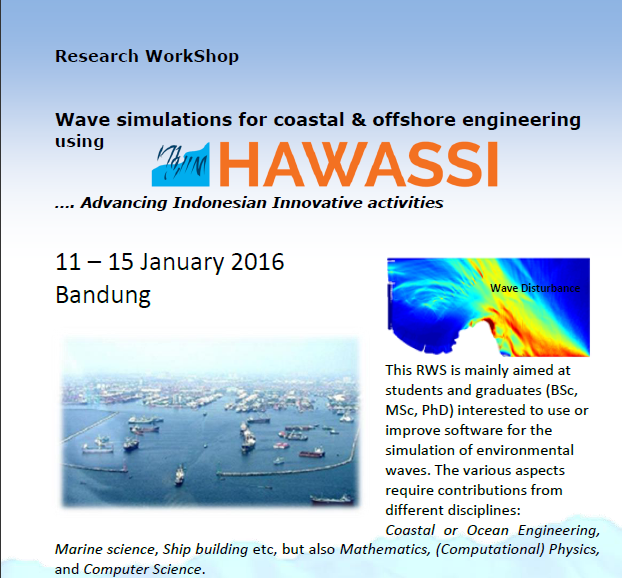Research WorkShop:
Wave simulations for coastal & offshore engineering using
This RWS is mainly aimed at students and graduates (BSc, MSc, PhD) interested to use or improve software for the simulation of environmental waves. The various aspects require contributions from different disciplines:
Coastal or Ocean Engineering, Marine science, Ship building etc, but also Mathematics, (Computational) Physics, and Computer Science.
Good performance during the RWS can lead to the offer to execute an internship (or university thesis project) at LMI or to become researcher to support the development of the HAWASSI software (www.hawassi.labmath-indonesia.org).
Organization of the RWS
The workshop consists of lectures, exercises and example simulations. In the afternoon session exercises by teams of 4 participants.
Lecturers/Supervisors:
Dr. D. Adytia, M. Woran, M.Sc, A. Wijaya M.Sc and Prof. E. (Brenny) van Groesen.
Participants will get the RWS-material that includes free copies of the HAWASSI-software, lunches.
For the target group, the symbolic fee is 50.000 Rp; for others the fee of 5 Million Rp may be reduced, depending on the situation.
Registration
Selection of (at most 15) participants will be judged based on CV, letter of motivation and academic records, and early time of registration. Please register by sending an email to hawassi@labmath-indonesia.org with the requested information.
Registrations need to be received before 6 January 2016; for the target group, info about acceptance will usually be within 2 days after receiving the registration.
HAWASSI software is designed for the simulation of realistic waves in wave tanks (1HD) and coastal and oceanic areas, harbours, etc. (2HD).
HAWASSI can simulate water waves in a way that is competitive or better than other existing software.
The software comes in 2 different implementations of the basic equations; in the RWS we will deal with the version that uses a Finite Element implementation, the so-called
HAWASSI-VBM (Variational Boussinesq Model) as well as the spectral implementation, the so-called HAWASSI-AB (Analytical Boussinesq).
Features of the HAWASSI code include
- Exact energy conservation
- Boussinesq-type of equation (dimension reduction) with robust FE implementation (VBM) and spectral Implementation (AB)
- In AB, exact dispersion
- In VBM, the quality of dispersion is optimized for the specific wave problem to be simulated, which makes it possible to simulate deep ocean waves or very short waves (kh=10 or more) and infragravity waves
- Use of an unstructured grid with mesh-size depending on bathymetry (VBM)
- Various methods for wave influx from interior line
- Use of efficient damping zones, (partially reflecting) walls for harbour lay-outs
Facilities of the software include
- GUI’s for input of wave and model parameters, for generation of an unstructured mesh (VBM) and for post-processing
- Project examples with different waves and bathymetries, manual for easy operation and scientific description.
Examples of excercises
- ‘Real’ seas: short-crested wind & swell
- Waves in a harbour
- Wave reflection from under-water bar
- Extreme wave statistics
- Infragravity waves
- Internal flow and forces on structures.
- Future Research Topics
DEC



